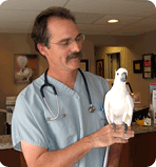Scarlet macaws with feather damaging behaviors directed towards their moulted feathers

Dear Dr. Speer and Staff; Thank you for taking time to consider my question. We have two adopted wild-trapped scarlet macaws, both of whom are nearing fifty years of age at least. The second one we took in, a hen, became close companion to the male within a week of her arrival here; and the two spent much of this autumn “playing house” in Romeo’s nighttime sleeping barrel (he is arthritic). To our surprise, Aura actually laid three strong eggs—fortunately infertile, but thoroughly protected and set upon for a month or so by the loving pair. My question is this: a few weeks after the incubation and nesting urge was abandoned by the macaws, one or both of them began eating the shafts of all their molted feathers, especially the large ones. Is there something in feather quills which can provide nutrition for psittacines? I have seen this in other parrots, but only those who feather pluck and I assumed it was for chewing diversion. The macaws are on a super diet of fresh raw foods, cooked and sprouted grains, nuts, organic seed and extruded pellets, plus they got calcium mineral supplement four times a week when it was discovered they were in a nesting mode. Thanks again for your time and consideration.

Dear Eb - In short, it should be doubted if there is a nutritional need that is driving this feather damaging behavior of this pair. Other “purposes” for this behavior should be considered, including but not limited to a displacement activity to perceived stressors. Sometimes, such a behavior may be related to the perceived “stress” of an unhatched clutch and the removal of those eggs, and limited other activities with which to let it off with. One consideration, presuming this to be at least in part involved here, would be to enrich the nesting and flight site with materials that can be chewed, frayed and functionally mulched that may have equal if not greater value to the birds over chewing their own moulted feathers.

































